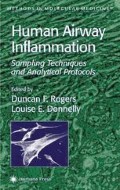Abstract
Exhaled air is saturated with water at 37°C, and cooling causes condensation of this water vapor. Breath condensate can be analyzed for the presence of inflammatory mediators and other putative markers of inflammation, among which are hydrogen peroxide (H2O2), leukotrienes (LT), prostanoids, thiobarbituric acid reactive products (TBARs), and metabolites of nitric oxide (NO), including nitrites and nitrates. The methodology for these measurements has not been standardized. There is very little, if any, direct evidence that concentrations of substances detected in breath condensate actually reflect their concentration at the level of the intrapulmonary airways. However, studies that have correlated breath condensate findings to the presence and severity of lower airway disease suggest that this might be the case.
Access this chapter
Tax calculation will be finalised at checkout
Purchases are for personal use only
References
Nowak, D., Antczak, A., Krol, M., Pietras, T., Shariati, B., Bialasiewicz, P., et al. (1996) Increased content of hydrogen peroxide in the expired breath of cigarette smokers. Eur. Respir. J. 9, 652–657.
Antczak, A., Nowak, D., Shariati, B., Król, M., Piasecka, G., and Kurmanowska, Z. (1997) Increased hydrogen peroxide and thiobarbituric acid-reactive products in expired breath condensate of asthmatic patients. Eur. Respir. J. 10, 1235–1241.
Dohlman, A. W., Black, H. R., and Royall, J. A. (1993) Expired breath hydrogen peroxide is a marker of acute airway inflammation in pediatric patients with asthma. Am. Rev. Respir. Dis. 148, 955–960.
Jöbsis, Q., Raatgeep, H. C., Hermans, P. W. M., and De Jongste, J. C. (1997) Hydrogen peroxide in exhaled air is increased in stable asthmatic children. Eur. Respir. J. 10, 519–521.
Jöbsis, Q., Raatgeep, H. C., Hermans, P. W. M., and De Jongste, J. C. (2000) Hydrogen peroxide and nitric oxide in ehaled air of children with cystic fibrosis during antibiotic treatment. Eur. Respir. J. 16, 95–100.
Horváth, I., Donnelly, L. E., Kiss, A., Kharitonov, S.A., Lim, S., Chang, K. F., and Barnes, P. J. (1998) Combined use of exhaled hydrogen peroxide and nitric oxide in monitoring asthma. Am. J. Respir. Crit. Care Med. 158, 1042–1046.
Ho, L. P., Faccenda, J., Innes, J. A., and Greening, A. P. (1999). Expired hydrogen peroxide in breath condensate of cystic fibrosis patients. Eur. Respir. J. 13, 103–106.
Worlitzch, D., Herberth, G., Ulrich, M., and Döring, G. (1998) Catalase, myeloperoxidase, and hydrogen peroxide in cystic fibrosis. Eur. Respir. J. 11, 377–383.
Jöbsis, Q., Raatgeep, H. C., Schellekens, S. L., Hop, W. C. J., Hermans, P. W. M., and De Jongste, J. C. (1998) Hydrogen peroxide in exhaled air of healthy children: reference values. Eur. Respir. J. 12, 483–485.
Becher, G., Winsel, K., Neubauer, G., and Stresemann, E. (1997) Breath condensate as a method of noninvasive assessment of inflammation mediators from the lower airways. Pneumologie 51(Suppl. 2) 456–459.
Carpenter, C. T., Price, P. V., and Christman, B. W. (1998) Exhaled breath condensate isoprostanes are elevated in patients with acute lung injury or ARDS. Chest 114, 1653–1659.
Ho, L. P., Innes, J. A., and Greening, A. P. (1998) Nitrite levels in breath condensate of CF patients are raised in contrast to exhaled nitric oxide (NO) levels. Am. J. Respir. Crit. Care Med. 157, A125.
Scheideler, L., Manke, H. G., Schwulera, U., Inacker, O., and Hammerle, H. (1993) Detection of nonvolatile macromolecules in breath: a possible diagnostic tool? Am. Rev. Respir. Dis. 148, 778–784.
Author information
Authors and Affiliations
Editor information
Editors and Affiliations
Rights and permissions
Copyright information
© 2001 Humana Press Inc., Totowa, NJ
About this protocol
Cite this protocol
de Jongste, J.C., Jöbsis, R., Rolien Raatgeep, H. (2001). Breath Condensate as a Vehicle for Collection of Inflammatory Mediators, Especially Hydrogen Peroxide. In: Rogers, D.F., Donnelly, L.E. (eds) Human Airway Inflammation. Methods in Molecular Medicine, vol 56. Humana Press. https://doi.org/10.1385/1-59259-151-5:119
Download citation
DOI: https://doi.org/10.1385/1-59259-151-5:119
Publisher Name: Humana Press
Print ISBN: 978-0-89603-923-0
Online ISBN: 978-1-59259-151-0
eBook Packages: Springer Protocols

